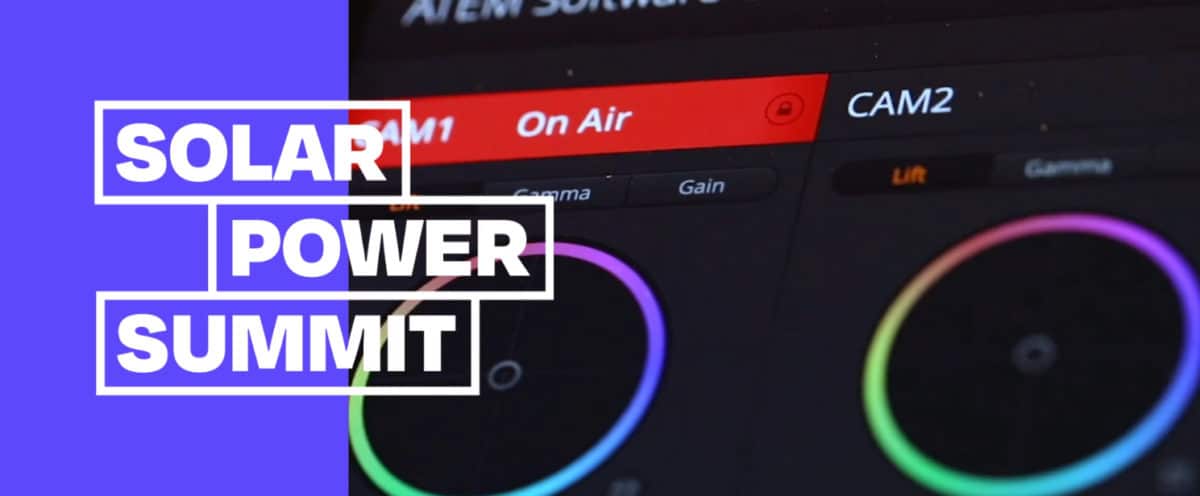It's sustainability wish time
Wade, from First Solar said it's all about accountability in the supply chain and having a level playing field. That's one line, it's true, but it might help to know more about which particular playing field he's referring to.
We are swiftly on to Wormser, the only man to openly mention the “human rights abuses allegedly happening in western China, where most of the world's polysilicon is being produced.” He stressed the fact sustainability should not be about a push message but, rather, a pull, with solar suppliers and buyers being on board with the need to be accountable.
Statkraft's Wood wrapped up by again emphasizing the importance of planning to promote biodiversity at renewables sites in order to win public acceptance.
And ROSI Solar chief exec and founder Yun appealed for technological advances to ramp up the recyclability of the components used to generate solar power.
And that's where pv magazine is going to wrap its coverage of this year's SolarPower Summit. We hope you've enjoyed an insight into the debates of the last few days and will keep an eye on our news feed for everything you need to know. And don't forget, the May issue of the magazine is now available to order here.
Cheerio!
A design... foooooor life
Yun Luo, whose French start-up ROSI Solar is a specialist in solar panel recycling and circularity, has called for modules to be made to be more robust because intact end-of-life products have significantly more value than broken ones, particularly regarding keeping their ribbons intact.
Statkraft's Wood touched upon the forced labor question and First Solar's Wormser drew a distinction between the U.S. approach, which could see clients able to avoid using panels made with forced labor, thanks to leadership from the industry, and the European approach, which is attempting to eradicate forced labor, rather than merely avoiding using such products.
Schmela is swiftly moving the question on now to public acceptance, given the vast solar and wind farms that are envisioned across Europe. How to avoid the NIMBY phenomenon.
It's all about communicating the benefits to local communities, including supporting community groups, says Statkraft's Wood. Supporting biodiversity at sites is universally accepted, she added.
It's warp up time with the now familiar one line sought from each panel member. What is most important on the topic of sustainability? To be continued…
Carbon, carbon, carbon
Paul Wormser, of Clean Energy Associates, has reinforced the sentiment carbon content is becoming an increasing issue, even to the point of being aware of the transport emissions of the trucks transporting panels to sites.
He wants panel suppliers to take more responsibility for recycling module materials and pointed to the example of one manufacturer who supplied products under the strict instruction they not be installed in Washington, where state requirements would place a heavy reuse burden on the manufacturer.
Although plans for a bill in California to require the recycling of 100% of solar panel raw materials fell short, added Wormser, it served to show the industry – and customers – are increasingly sensitive to the issue.
Zero-carbon?
Wade is explaining the perception of solar as a zero-carbon electricity source is swiftly changing under scrutiny into the embedded carbon footprint of solar panels, which of course are widely produced with the use of cheap, coal-fired electricity.
Session chair Michael Schmela, executive adviser and head of market intelligence for SolarPower Europe has asked Susannah Wood, of Statkraft-owned PV developer and EPC Solarcentury, what guides that firm's buying decisions.
LCOE, is the immediate response, but with a focus on the full lifecycle of the project, not on a short-term cost basis. Wood said, ideally, increasing environmental, social and corporate governance spending in the sector might eventually result in helpful pricing for more sustainable projects, although she acknowledged that may be a naive sentiment.
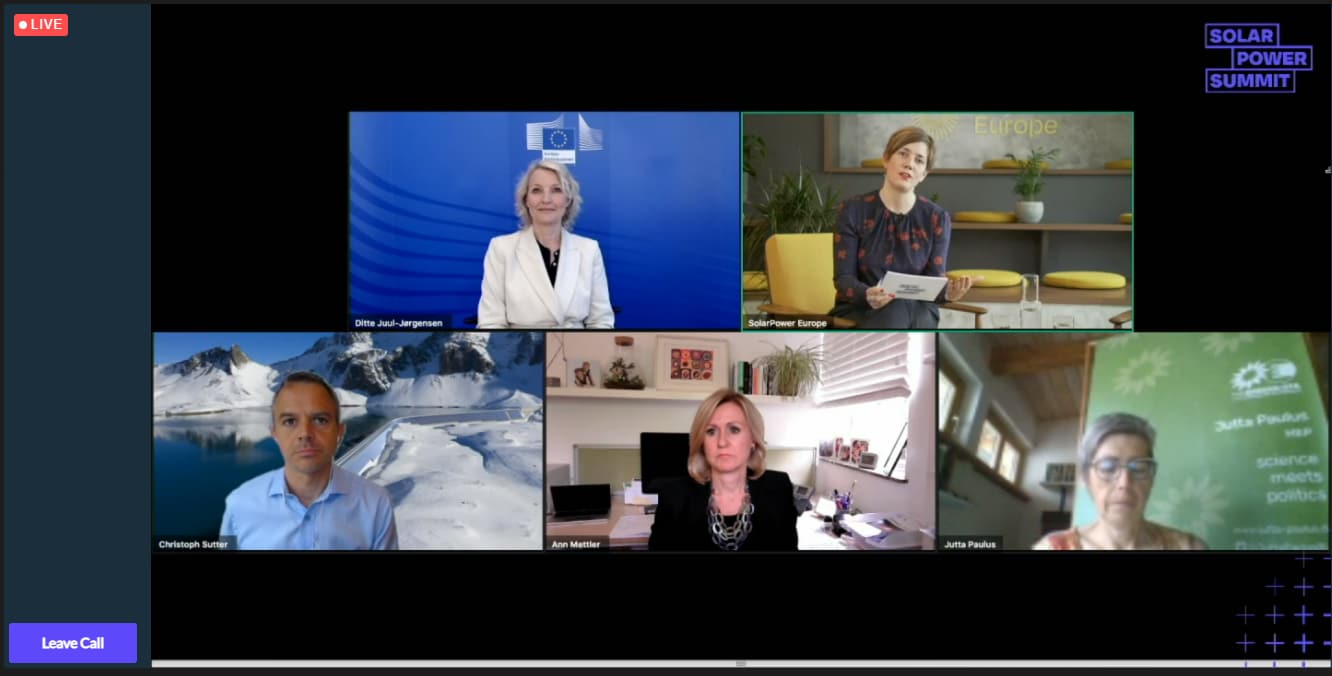
Why should we be sustainable?
Andreas Wade, global sustainability director for U.S. module manufacturer First Solar is walking us through the reasons why solar needs to address sustainability. This comes after conference chair Walburga Hemetsberger channeled her inner superhero by reminding us all: “With great power comes great responsibility.”
Wade is saying stakeholders are expressing rising interest in the embedded carbon involved in generating solar power, and how that figure can be reduced. He is also pointing out regulators are bearing down on the need for a circular approach to manufacturing and recycling as well as the industry's use of hazardous materials.
Now we're onto the thorny question of human rights, although Wade is diplomatically tiptoeing around the topic by talking in general terms about the need to follow protocols which are widely applied to other industries.
Back live
We're back in the game for this afternoon's sustainability session, which will see SolarPower Europe launch its PV Sustainability Benchmark.
Here goes…
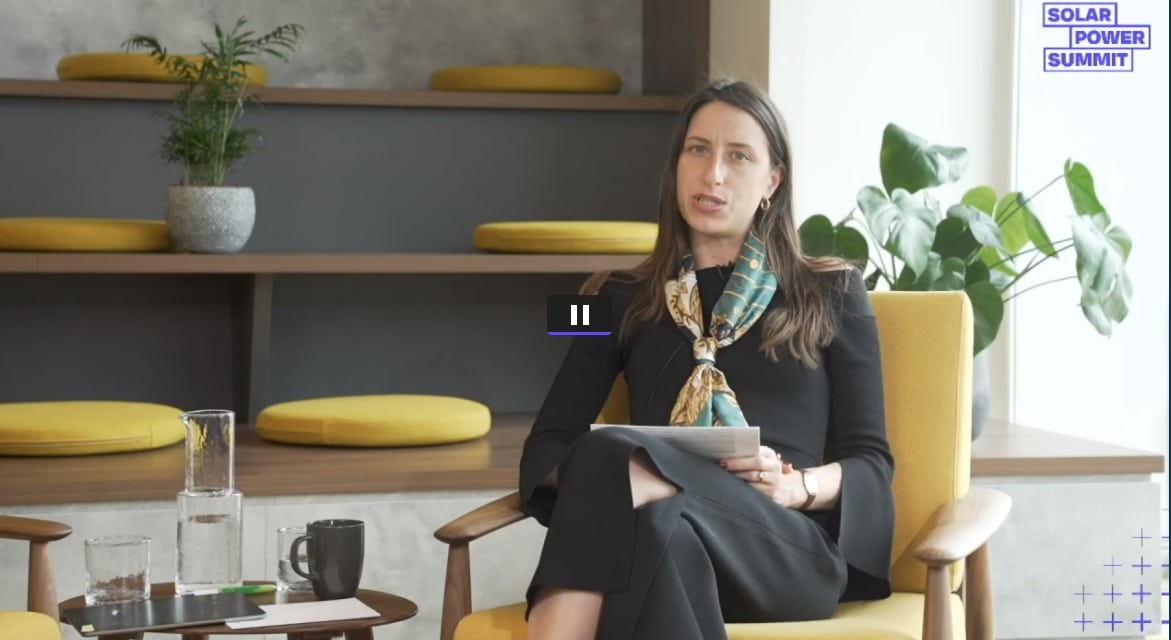
That's it for Solar4Hydrogen
Aurélie Beauvais, Deputy CEO of SolarPower Europe has expertly guided this discussion of solar and green hydrogen to its conclusion.
And among the conclusions reached were some of the answers to Beauvais's initial questions. “How can we power Europe's renewable hydrogen ambition from supply to demand?” Well, according to our speakers we have to start vice versa, from demand to supply.
As to whether blue hydrogen will carry the bulk of uptake in the initial years of the hydrogen economy our speakers could not be sure, but they could be sure that definitions are very important, especially if a carbon mechanism is brought in to reward green hydrogen producers and hinder projects who continue to emit.
Moreover, while everyone also agrees that the hydrogen economy is evolving at a breakneck speed, the pace is still not fast enough, there is a significant bottleneck and being more flexible is conditional on removing that grid-based bottleneck.
Make sure you register for our pv magazine Roundtable on hydrogen on June 10 at 2pm CEST. We will discuss whether it makes sense for solar project developers and investors to consider a link to hydrogen production and how this would work, among other topics.
Finally, thanks for following along, and stay tuned for more live pv magazine coverage from the 2021 Solar Power Summit tomorrow.
We have no time to waste
From Ulrik Stridbæk's perspective, “the most important thing is to get projects off the ground, so that we can start to learn and industrialise across the value chain.”
This means that some of the touted gains of green hydrogen farther down the line, its potential use as aviation fuel for instance, while important, must not receive priority over the getting of scale projects off the ground and into working conditions, which is to say, learning conditions.
“We don't have time to wait for aviation fuel etc., we have to get started.”
There must be a carbon mechanism
Christian Pho Duc pulls no punches when it comes to the question of a CO2 emissions mechanism. There must be a cost on industries resting on their laurels and refusing to innovate and reduce emissions, just as there must be an incentive to innovate and reduce emissions.
“There must be an incentive for those industries who decide to go into decarbonisation that they have a reward” Duc said. “CO2 should be paid for without so many exceptions as there are now. It needs to hurt when you continue to emit CO2 instead of innovating and progressing. There needs to be a clear business case based on this mechanism.”
Definitions are crucial
Much like ambitions for green hydrogen, agreement between our speakers is not in short supply.
“First and most important,” declared Ulrik Stridbæk, “we cannot call hydrogen green if it is keeping fossil fuel plants alive…We can't ruin the environment while trying to save it.”
In her closing remarks, Carina Krastel seconded Stridbæk. “The devil is in the detail” she said. “We have to be careful when it comes to what is renewable hydrogen and what is not renewable. From the demand side definitions are crucial. What is green steel? What is green cement? Products that we are trying to decarbonise upstream, how do they fair downstream?”
Consensus on demand-drive
All the speakers agree that the push behind green hydrogen has to be “demand-driven.” And that talking about green hydrogen is very different to most other discussions, it is freighted with its own unique complications, most of which have not yet even realised. After all, when it comes to decarbonising industry, we are no longer just talking about “powering the wall”, to use the words of Ulrik Stridbæk.
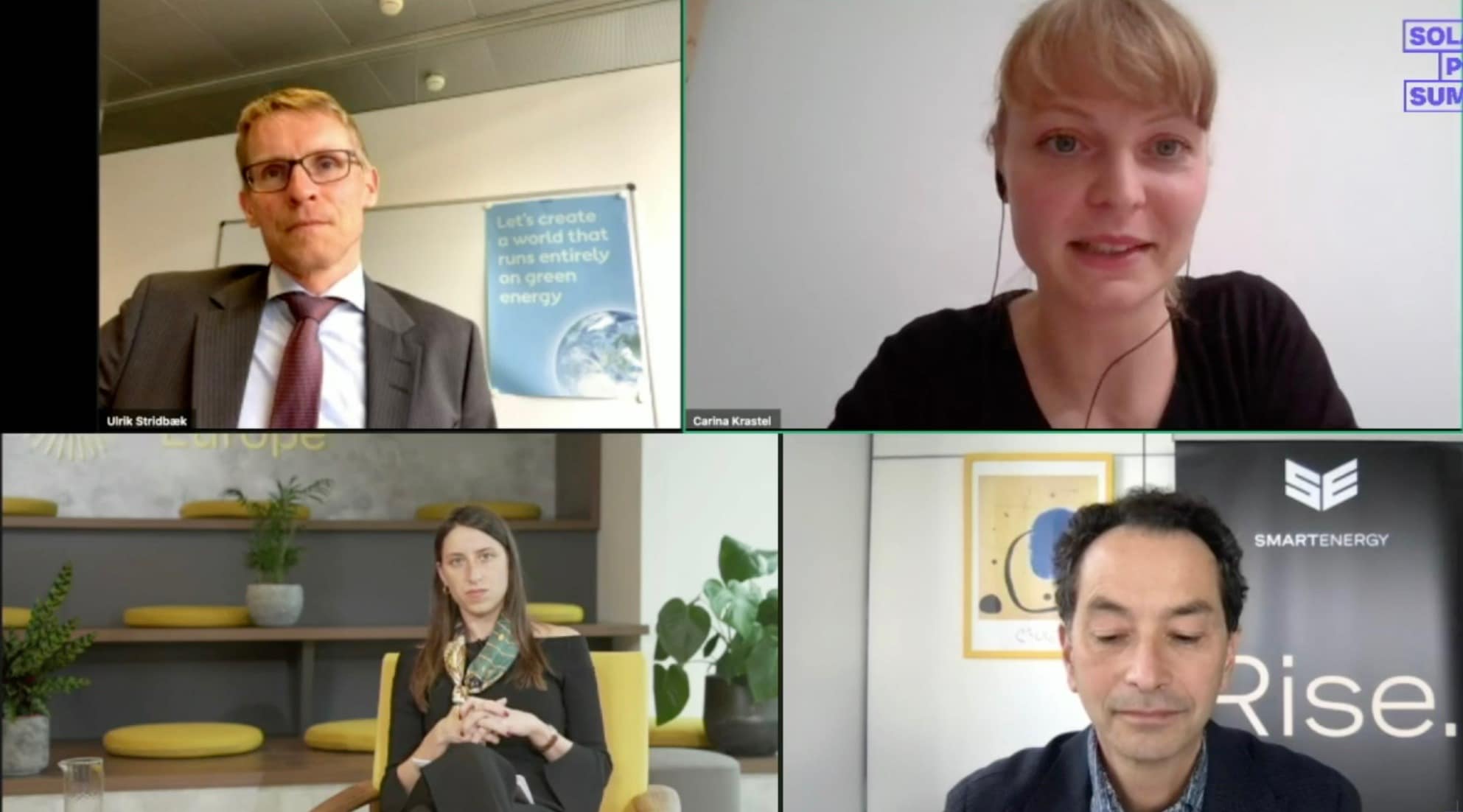
That old question, the chicken and the egg.
All the speakers are somewhat reassured by each other's confessions of just how difficult it is proving to get green hydrogen projects off the ground.
“There are many chicken and egg situations,” Stridbæk says. “It is important to find a way to accommodate those off-takers who want to be on the forefront.”
Such is the dilemma, those at the forefront will pay the most and those that follow will benefit from those costs. But, well, somebody's gotta do it…
“The kick-off process is about finding the balance,” Stridbæk continued. And as Christian Pho Duc, Managing Director H2 Projects at Smartenergy and Vice-Chair of SolarPower Europe's renewable hydrogen Workstream stressed, “We need to make sure we don't cannibalise…These first projects are taking the biggest risk, but they are needed to bring the costs down.”
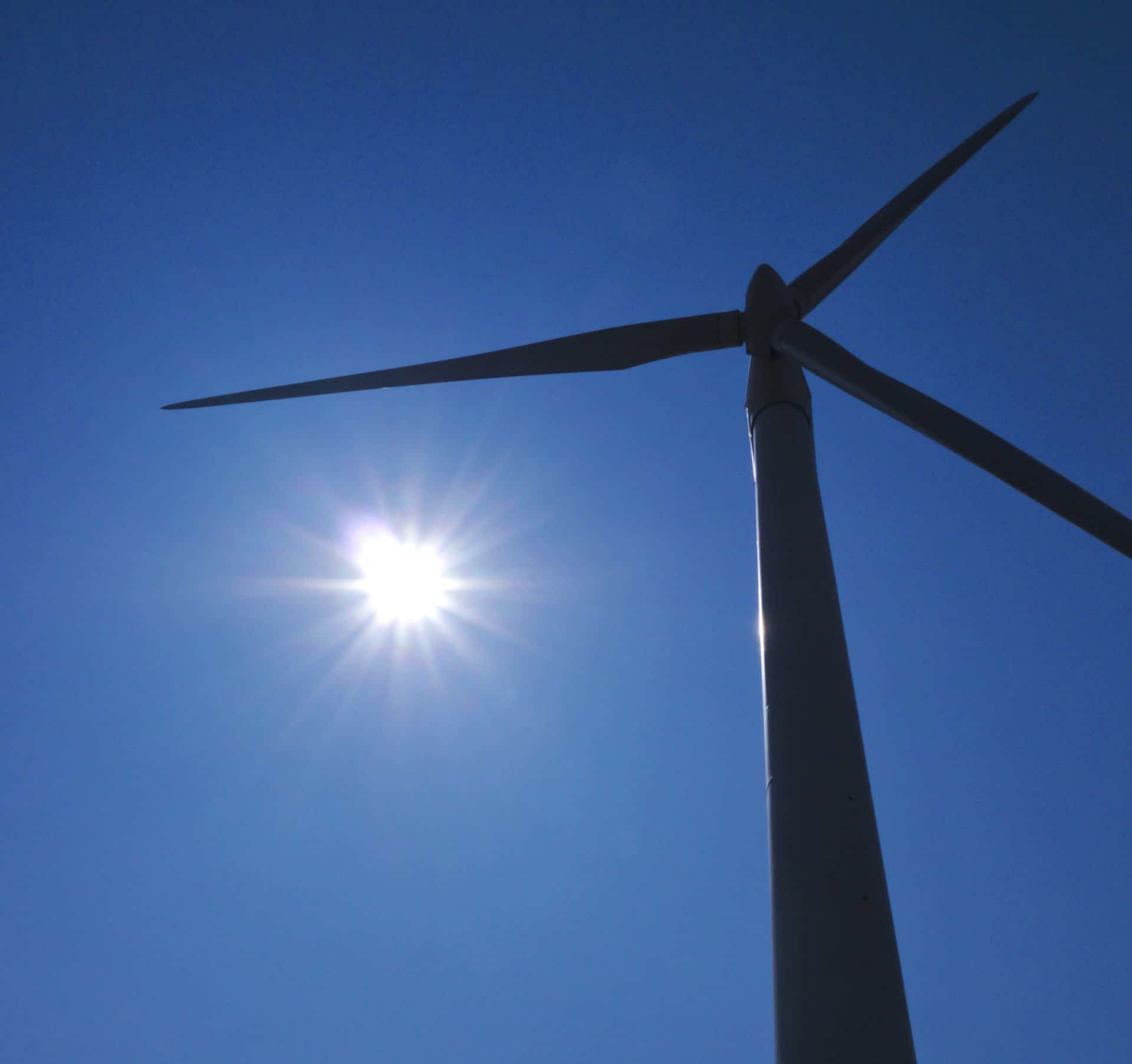
Solar vs. Wind
Stridbæk, who was not shy about being primarily a offshore wind guru, makes an interesting comparison between the two great elemental resources.
“Solar PV has the advantage that it can be quickly built, but maybe the disadvantage at most quarters that it is difficult to scale. At the other end, offshore wind is easy to scale up, but it takes years to plan and execute, which makes it hard to time with a certain size of electrolyzer.”
"This is a true bottleneck."
Ulrik Stridbæk, VP, Head of Regulatory Affairs, Ørsted, has candidly responded to the question as to whether we are on track to meet the European Commission's targets for renewable hydrogen.
“No, we are struggling. It’s not going forward quickly enough. There is not sufficient projects, too much struggle. This is a true bottleneck.”
The main problem, Stridbæk says, when it comes to getting to net zero by 2050, is not ridding ourselves of fossil fuels but meeting the new and enormous electricity demand which is expected to increase 150%.
After better and cheaper electrolyzers and cheap electrons, the grid, declared Stridbæk, represents “the final chunk.” “The grid is just not there…” he says. “From 2025 and over the next 10-15 years, we need robust additionality criteria, no doubt.”
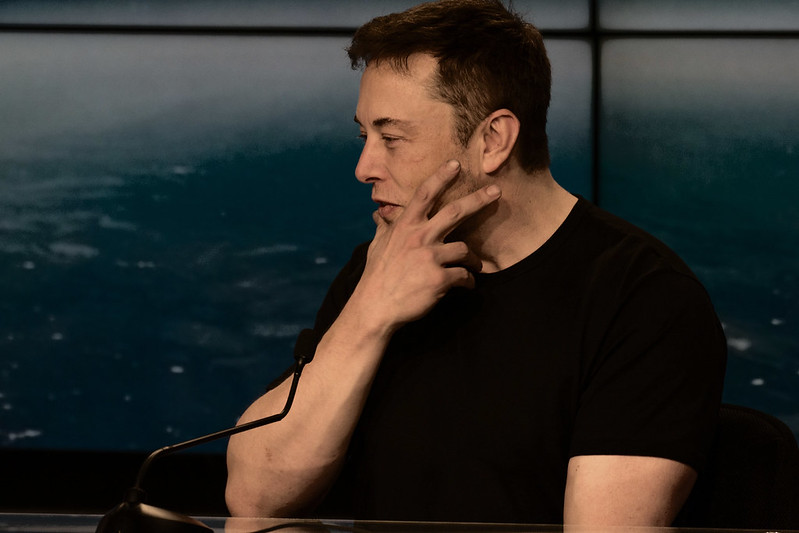
Building the value chain of green steel
Carina Krastel from InnoEnergy and the European Green Hydrogen Acceleration Center (EGHAC) makes the case for the demand perspective.
When it comes to cleaning up the steel industry, it is the demand side, says Krastel, that needs to put its foot to the floor. “We have invested to produce green steel from green hydrogen in greenfields, with final production in 2030, the innovative part of it is following the value-chain approach, starting with demand, with the end-user in mind.”
“What we want to avoid as a European initiative,” continued Krastel, “is that a family has to buy a Tesla from Nevada and not from a European carmaker.” Of course, this is not a stab at the Saturday Night Live Host, Elon Musk, but making the point that Europe, like other regions, can utilise green hydrogen to make their own value-chains sustainable and affordable.
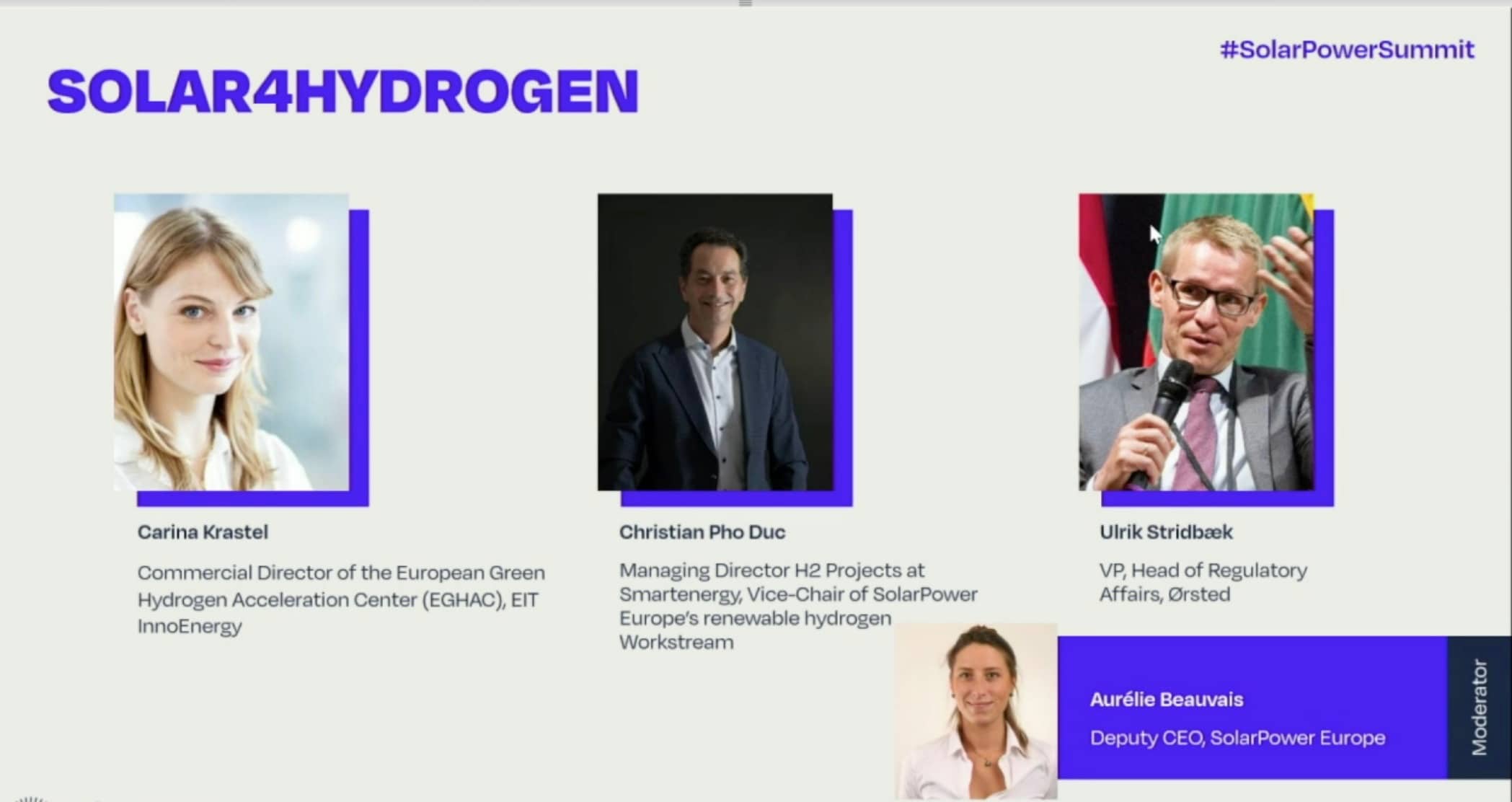
Solar4Hydrogen is underway at Solar Power Summit 2021
We're live and unmuted with Solar4Hydrogen. Hydrogen and green hydrogen specifically, is touted as one of the great revolutions on the horizon. With so much to talk about, some milestones for the talk are in place:
Is green hydrogen the missing link to decarbonise industry?
And can green hydrogen be a real European success story?
How can solar contribute to the green hydrogen success stories?
What are the key policy milestones?
How can we get €1.5/per kilo by 2030?
Time is against us
The point Paulus was trying to make, as she battled with her router, was that we need to do more with what we've already got. “The innovations in solar-plus-storage should be welcomed over Europe,” said the Green MEP. “But don't rely on innovations alone. We must push forward the solutions we have today, because we don't have time indefinitely [long break with indistinct speech] on the contrary, time is running out ever shorter.”
That last comment allowed chair Hemetsberger the perfect segue to start winding down but not before asking each member of the panel what they might expect from the commission's Fit for 55 package. Which made it a shame Juul-Jørgensen appeared to have already departed.
Mettler, perhaps not surprisingly, said: “For wind and solar, it took 25-30 years. We don't have that, so accelerate the innovation cycle,” presumably not referring to a mode of transport soon to be available, tax-free from Amazon.
Christoph Sutter, head of renewables at Swiss clean energy trader Axpo, repeated his call to incentivize companies to shift their production operations and energy consumption patterns to better match clean power generation profiles.
Paulus closed the session with a call for sector coupling which included removing the taxes and surcharges slapped on electricity generation and applying them instead to carbon fuels. Amen to that. She added: “When sectors can switch easily between district heating and cooling, transport, storage … then we can unleash the true potential of renewables.”
Hold on, hold on...
MEP Paulus has taken issue with that statement about innovation, however, and wanted to stress ramping up existing technology to a much greater degree is as important, if not more so, as driving new tech discoveries.
That might have all been a civil enough exchange until the German politician said: “I don't think it's the 50% [of new tech required] that Ann has been talking about. I read the interview with Bill Gates but the scientists I've spoken to have told me differently.
At which point, Gates representative (kind of) Mettler said: “My data comes from the International Energy Agency, so a reputable source.” Given the IEA's regular under-appreciation of solar, though, that may not be a sentiment much of our readership agree with.
On a more sinister note, Paulus regularly dropped out of the debate entirely due to a poor internet connection, including when she disagreed with the representative of a membership group of companies that also includes Jeff Bezos and Mark Zuckerberg among its Silicon Valley titans. Coincidence? We'll let you decide…
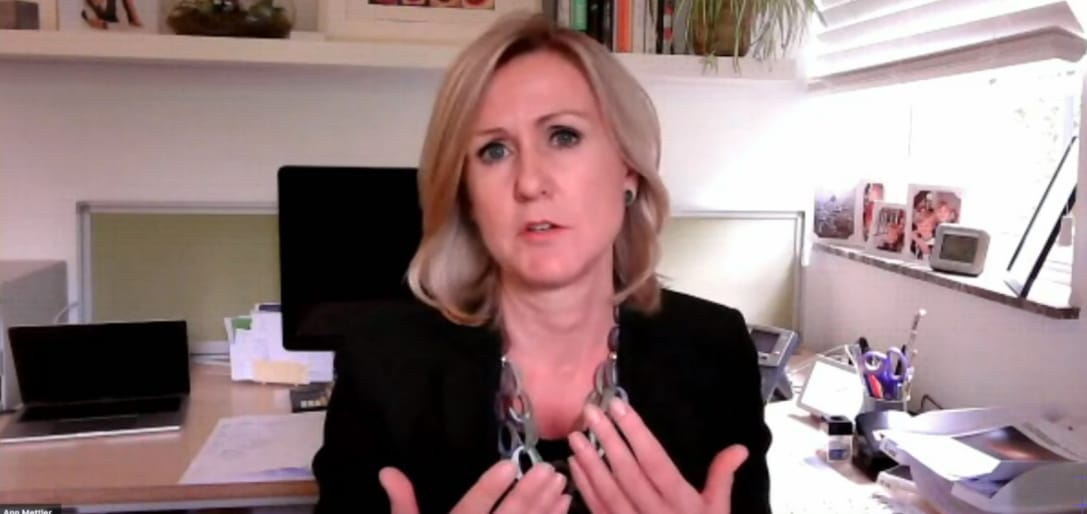
Lessons from across The Pond
Ann Mettler, VP for Europe at the Breakthrough Energy group of sustainable energy companies shepherded together by Bill Gates, has called for Europe to take a more all-encompassing approach to clean energy tech.
She said the region had a tendency to fall prey to one or two ‘flavor of the month' technologies and should encourage more diversity, as is the case in the U.S. She added, half of the tech needed to hit mid-century emission-reduction targets has not matured yet.
The Breakthrough rep was coy about specific technologies but, when pressed by chair Walburga Hemetsberger, pointed to the potential for Europe to be a global leader in renewable hydrogen, particularly with its application in heavy industries such as steelmaking.
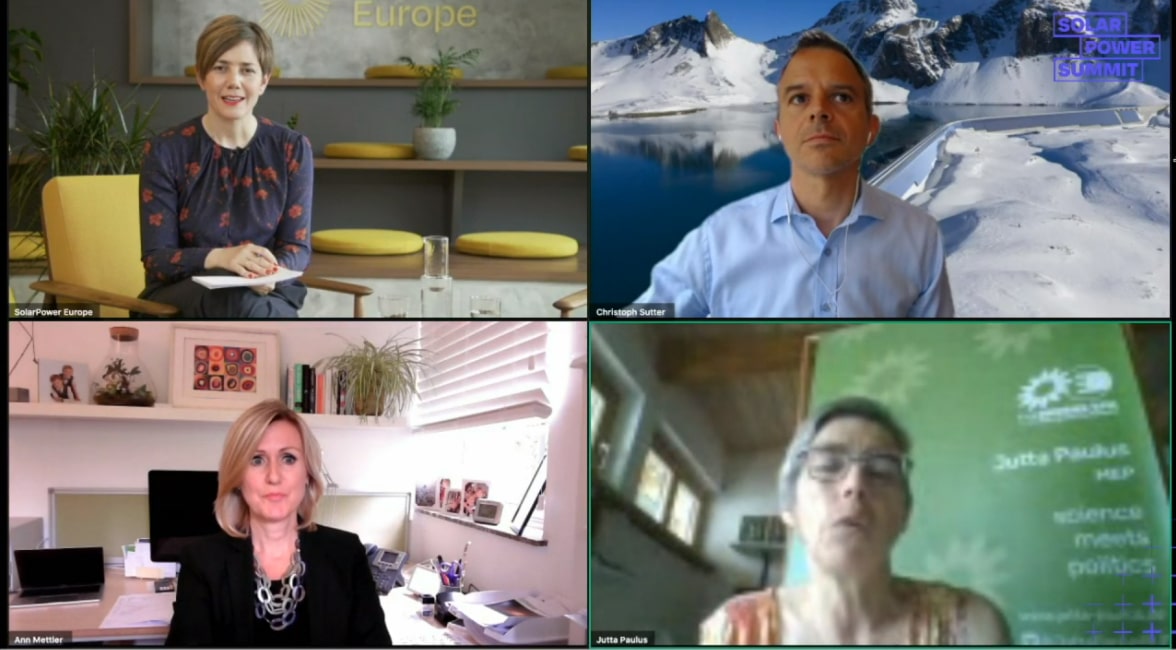
Should solar rooftops be mandatory?
Green Party MEP Jutte Paulus has called for solar to be mandated on European rooftops, as well as highlighting the potential of vertical solar facades in urban centers.
Asked whether installation should be mandatory, Paulus replied: “We have to make it mandatory, or else it won't function. And we have to make it easier. No business owner wants hassle from bureaucracy.” (That's right, we're back onto permitting, red tape etc once again).
The MEP said: “I think providing an aggregator, like a one-stop shop where you could go and tell them everything you need and get it with just one signature.”
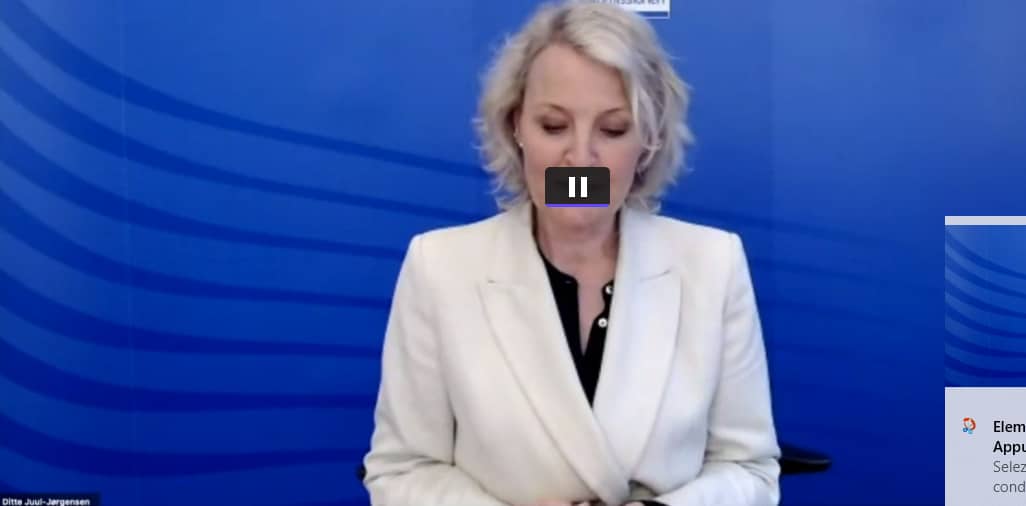
Fit for 55?
Ditte Juul-Jørgensen, director-general for the European Commission's energy secretariat has been outlining what has been achieved by legislators over the last year and has also pledged to deliver the commission's ‘Fit for 55' package, which is due “in the summer.”
That, of course, refers to confirmation the EU has finally committed to reducing carbon emissions, from a 1990 baseline level, by 55% this decade.
The bloc will need 38-40% of its electricity (or maybe energy, which would be more ambitious) from renewables by 2030, she said, and solar generation capacity across Europe can be expected to double by 2030, and triple by mid century, as part of a 500 GW clean energy fleet in Europe by the end of the decade.
Solar4Business
We're poised and ready to dive back into the solar high jinks at this afternoon's sessions of the SolarPower Summit 2021, starting with an event called Solar4Business. InfactI'mgivinguptheunequalbattleagainstSolarPower Europe'scrimesagainstgrammarandwillwriteallmycoverageinthisform.Thatalrightwitheverybody?
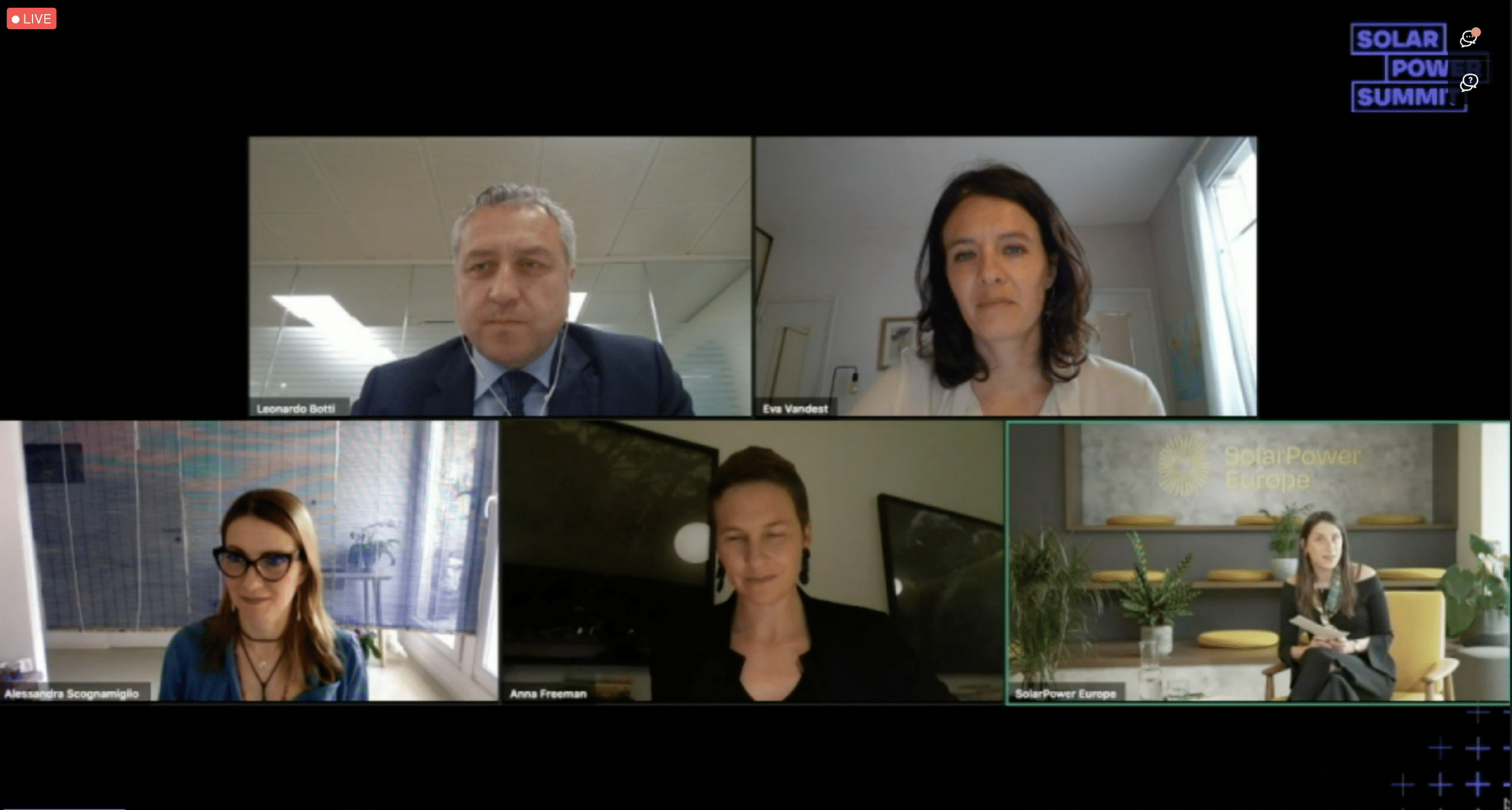
Building trust
Given pv magazine’s last UP Initiative quarterly theme on agriPV, we were particularly interested to sign on for the panel session, Solar4Agriculture with Anna Freeman, Policy Director, Energy Generation, Clean Energy Council (Australia), Leonardo Botti, Managing Director – C&I Line of Business, FIMER S.p.A, Alessandra Scognamiglio, Coordinator Task Force Sustainable Agrivoltaics, ENEA and Eva Vandest, Head of Public Affairs, Amarenco Group.
Thankfully, there were no technical difficulties during this session, which was used to launch SolarPower Europe’s Agrisolar Best Practice Guidelines. They outline how farmers, solar developers and policy makers should work together to develop sustainable plans and business models for the agriculture and energy sectors which, in Europe, are said to account for the first and second highest level of emissions.
As Vandest pointed out, farmers are already facing “major” climate change challenges, and they need “recognition and support” of this issue now. In response, the guidelines include a Sustainable Agriculture Concept (SAC), which lays out “must”, “should” and “could” criteria for developing solar PV projects on farmland and looks at the maximum synergies that can be achieved by combining the two sectors.
Of particular importance is building trust, which all panelists agreed is essential, particularly for policymakers and farmers, who need to understand the benefits of combining PV with agriculture – and countering the often-touted line that one must come at the expense of the other, particularly when it comes to land use.
Working with communities is also key to driving the sector forward, as Freeman pointed out. To this end, she and her colleagues recently released an Agrisolar guide for Australia, with a particular focus on grazing, which is the dominant form of AgriPV in the country.
You can download SolarPower Europe's new guidelines and read our Q1 coverage of AgriPV, which looked at business models, and trial projects, among other issues.
And watch out for the next sessions on Solar4Business and Solar4Hydrogen, coming up later today!
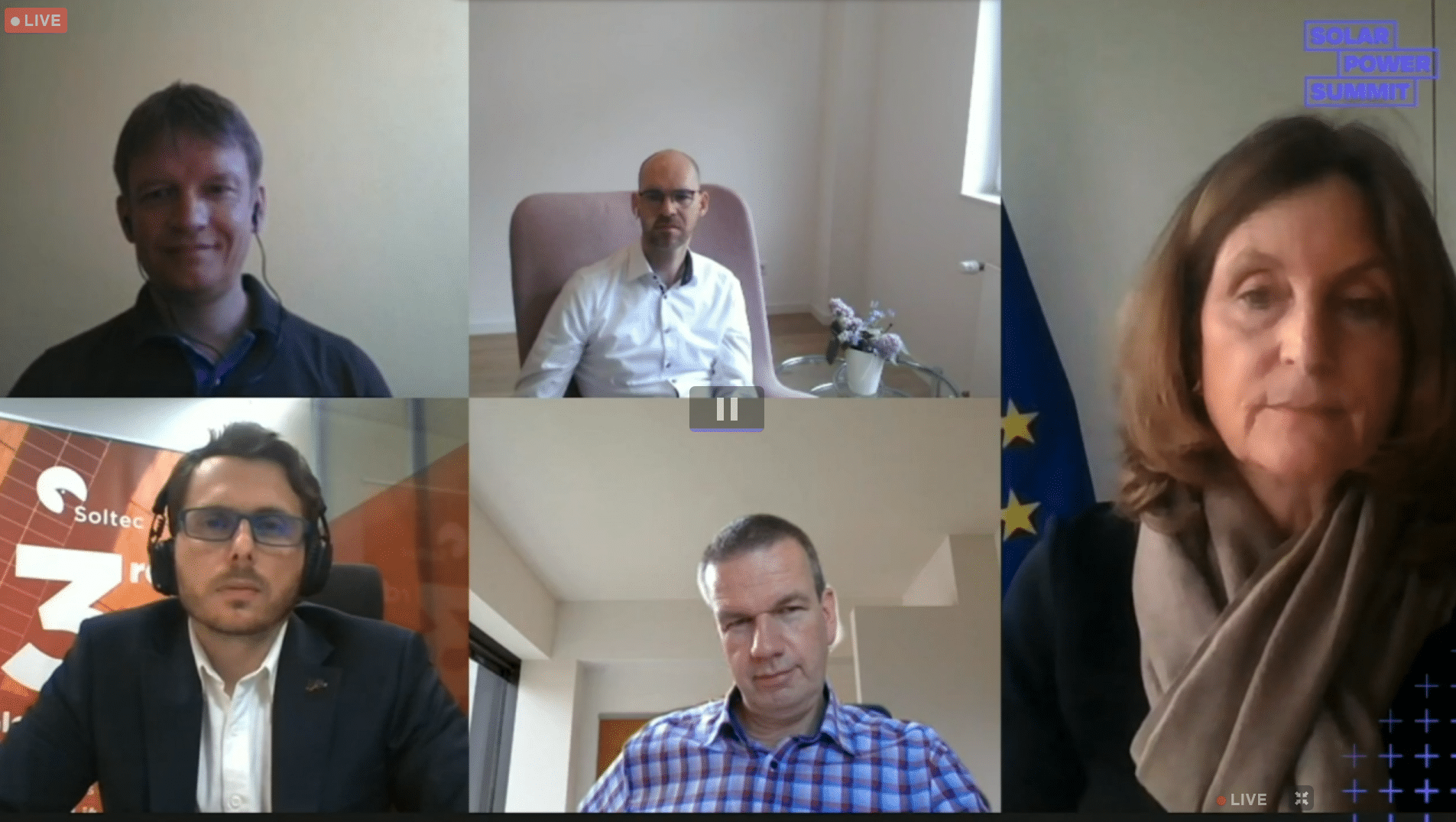
If we had one wish
Finally, the panelists are being asked for one wish from the EU, while Kerstin Jorne notes that she “is not Santa Claus”
Erfurt starts asking for a fair and level playing field, as well as funding. Soltec’s Eduardo de San Nicolas wishes for a focus on other areas, like hydrogen, where Europe can more easily take a leading role, and will help to decarbonize more difficult industries. And Wacker’s Christian Westermeier closes the round wishing for fast moving implementation of an overall strategy, “Speed” he says in a word.
Jorne’s response to these is that EU is determined to walk the walk with solar, and that the key is a collaborative approach with players and a clear strategy. “You can have as much money as you want, if you don’t have the project it doesn’t work.”
All we need is financing
The conclusion of this discussions seems to be that financing, both public and private, is the key element missing from Europe’s effort to rebuild a local solar supply chain. And the manufacturers on today’s are looking for EU support on this – whether that is providing money directly, or through incentives to promote private investment in the sector. “If we all join forces and are fast moving, that’s crucial at this stage,” says Westermeier.
And Erfurt concludes that Solar Power Europe’s target of 20 GW of manufacturing by 2025 is “absolutely doable”.
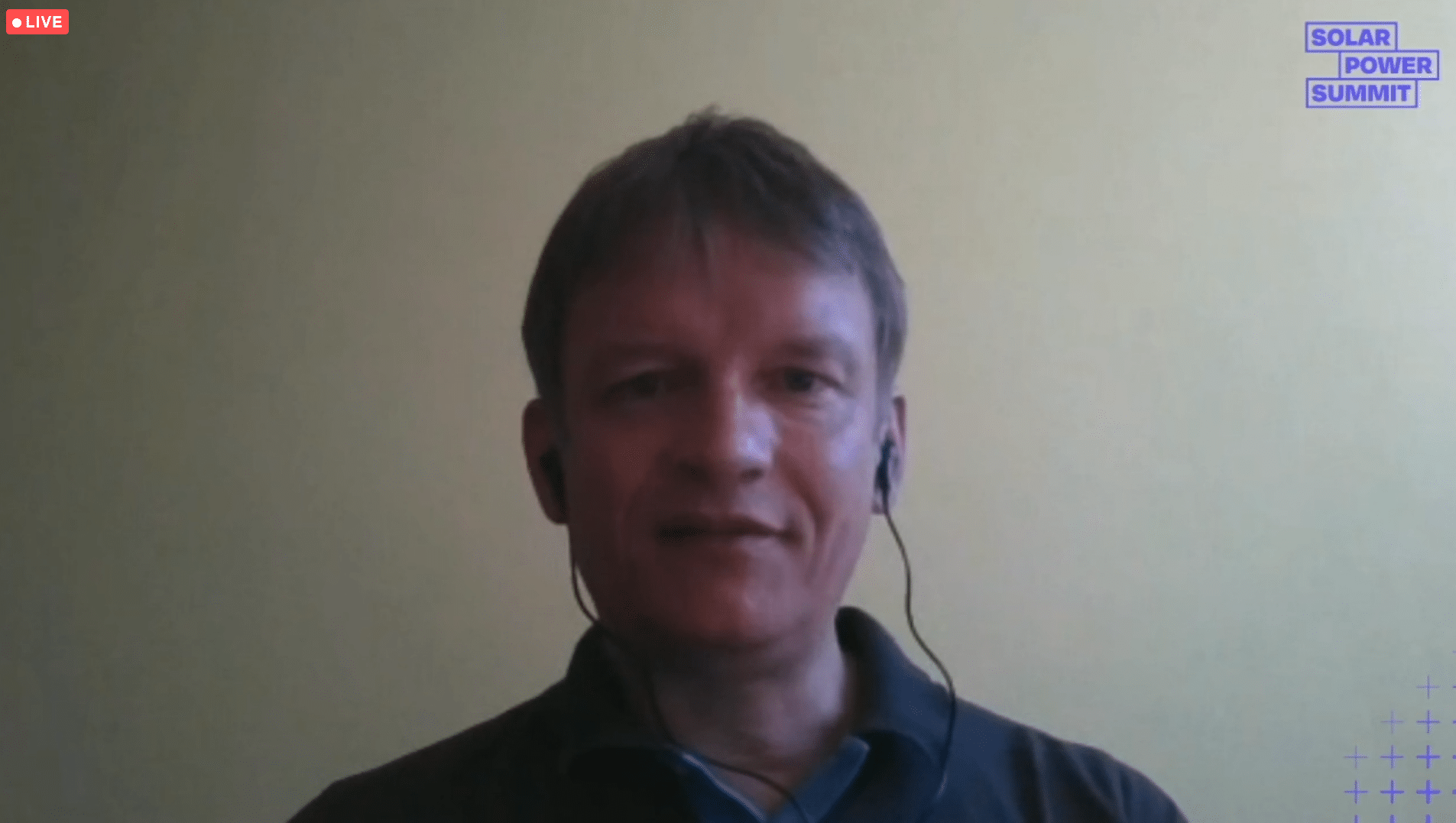
"We have never lost the competitiveness"
Erfurt believes that what the industry needs is a level playing field, that enable the industry to rebuild itsmanufacturing capacity in a sustainable way. And he brings up the thorny issue of tariffs, noting that while module and cell tariffs have been removed, they are still in place for glass and other module components, slowing the development of manufacturing.
“If we are not able to source components in Europe, which is currently not possible, we are penalized by tariffs. That is a no-go in our opinion.”
“It’s also about producing in a sustainable way”
With a question on Soltec’s willingness to pay more for “green” steel, the conversation has moved to sustainability. “If you give them a way to do it they will pay for it,” says de San Nicolas. He further notes that, even if Soltec demands green steel – it’s a challenge for steel producers to make this at a reasonable cost.
And the EC’s Kerstin Jorna is quick to step in, noting the EU’s €250 billion investment in sustainability standards and transparency for Europe – which will be important to reassure investors who are increasingly asking about companies focus on sustainability.

€5-6 billion, a pretty small number
Meyer Burger’s Erfurt says thanks to EU policy support, Europe is well placed to take a leading role in solar manufacturing. Getting the money in place is the next step. Asked by Kerstin Jorna how big the investment Europe would need to build up serious wafer and cell manufacturing in Europe, Erfurt places the figure at €5-6 billion, not including polysilicon, which he describes as a “pretty small number”
And on the polysilicon side, Wacker Chemie’s Christian Westermeier places the figure at €7 billion, noting that more is required to keep the industry running after this initial capital investment. “We need attractive access to electricity, land and infrastructure,” he tells the panel. And this, says Westermeier, may also require amendments to the EU’s state aid rules. “We are in global supply chains, and we have to deal with that,” he concludes.
Our main competitors are in the U.S.
Beyond modules, Soltec’s Eduardo de San Nicolas has a similar point of view: Trackers can be produced competitively in Europe, but it requires support from further upstream – in Soltec and tracker manufacturing’s case this means the steel industry.
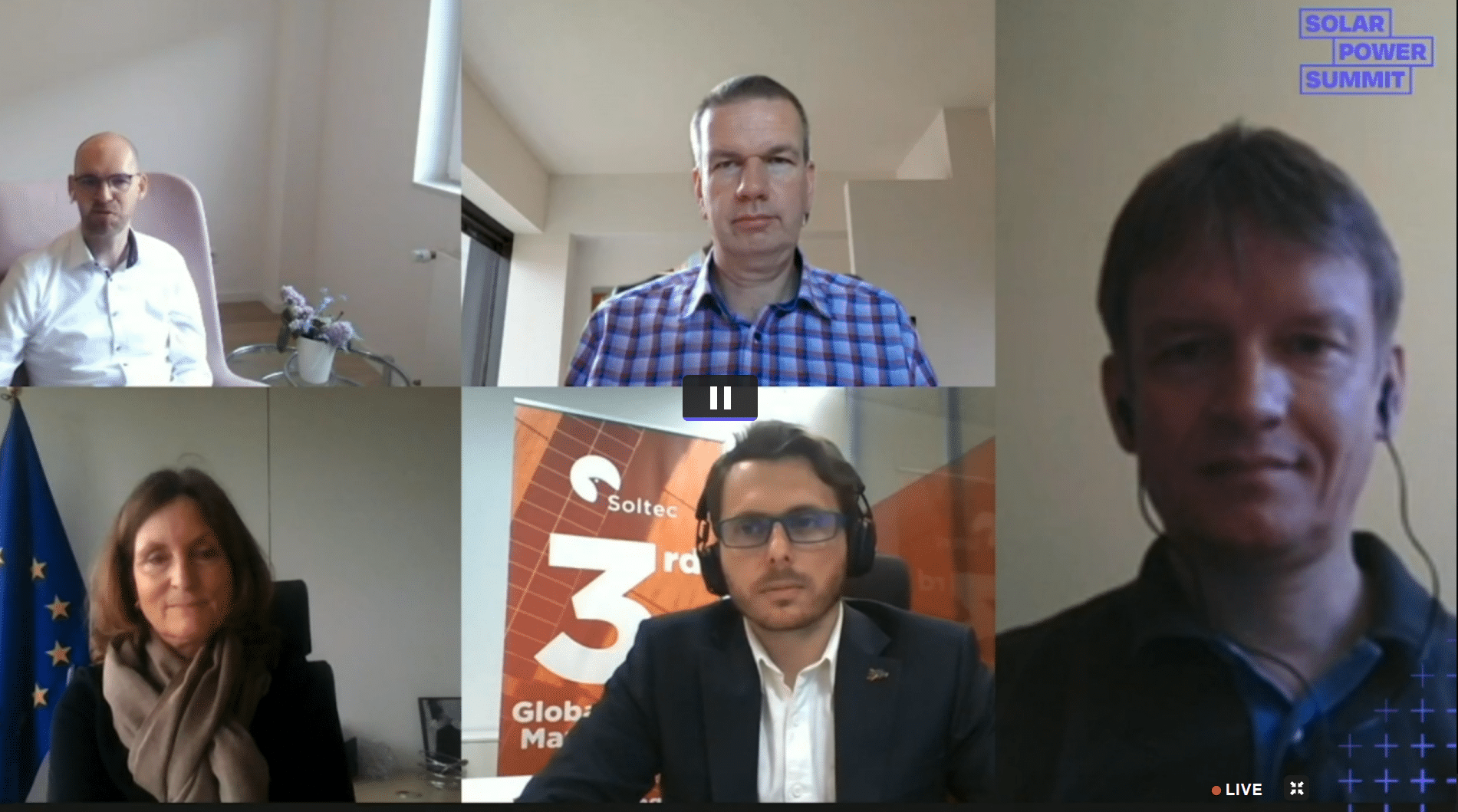
400 MW is a drop in the ocean
Meyer Burger CEO Gunter Erfurt stepped in to the panel discussion, noting that the 400 MW the company is opening this month is “a drop in the ocean” compared to PV manufacturing's scale in Asia. But it should be the start of reestablishing a European PV supply chain, and players like Meyer Burger will need support from further upstream. Over to Wacker Chemie…
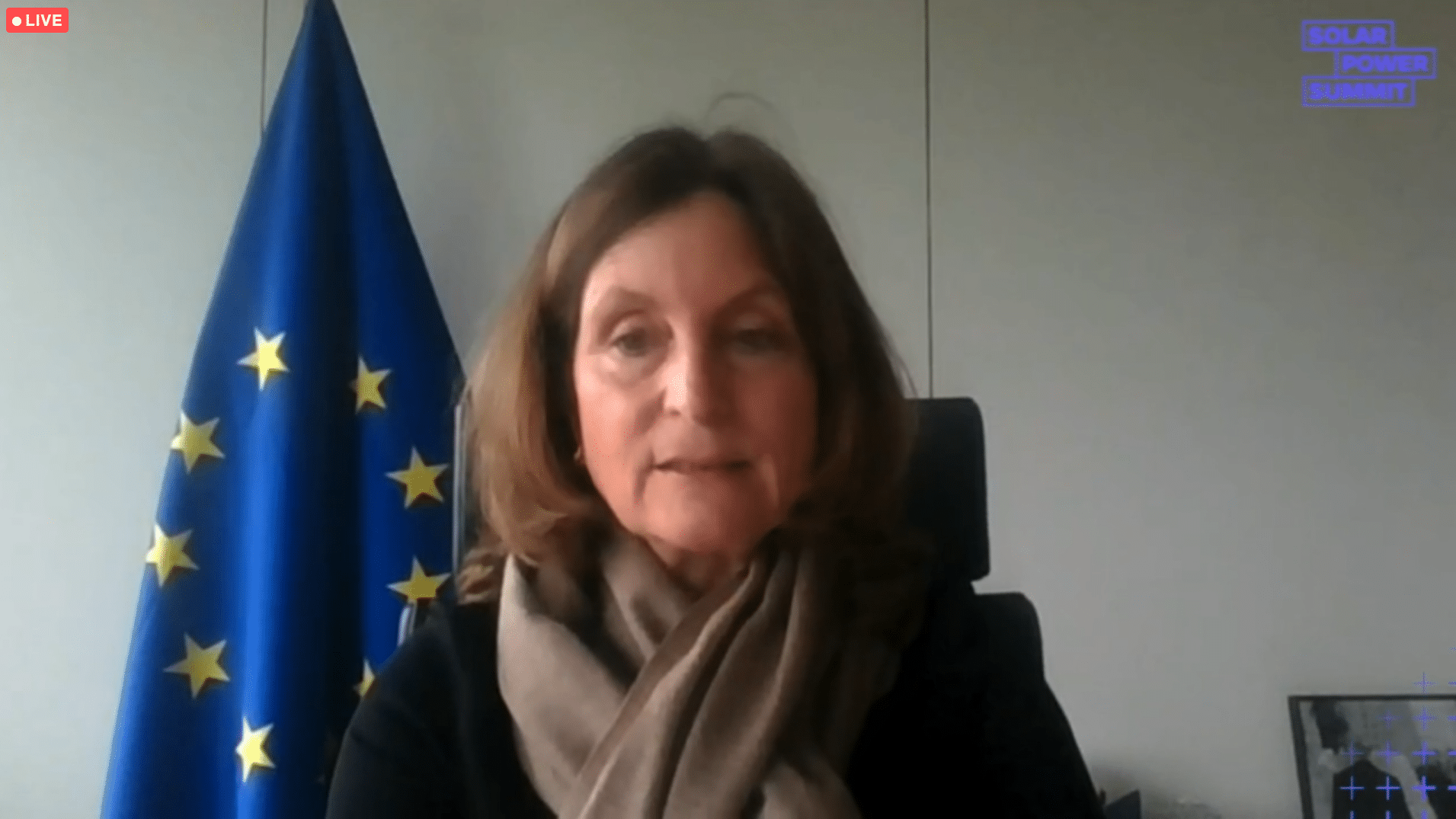
Industry tends to be where energy is
Kerstin Jorna, Director General of DG GROW , European Commission is opening up the session, laying out the EU's vision for more than 80% renewable energy by 2050, and the fundamental changes this will bring to the continent.
And a group of European solar manufacturing heavyweights is poised to weigh in!
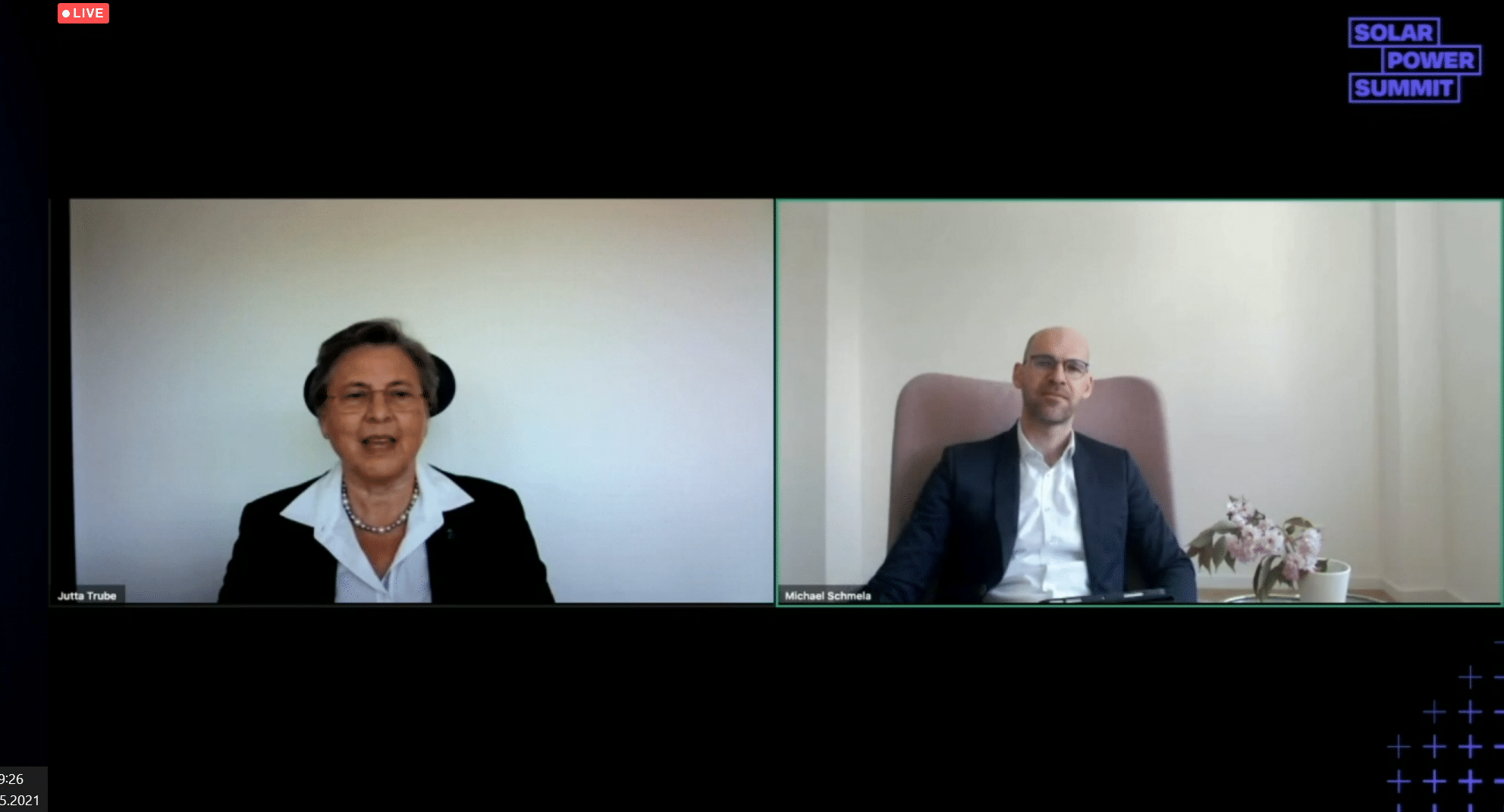
A place for European manufacturing
And the manufacturing session kicks off with SolarPower Europe's Michael Schmela chatting with Jutta Trube of Germany's VDMA. And Trube sees an important role for Europe in the future of PV manufacturing, but warns that finan
“It's all about financing. We need entrepreneurs, and a domestic development bank to back them and help them take the risks. The solar industry in Europe is ready, now it's about the politicians in the EU and at national level.”
Trube is also optimistic on the ‘next generation' of PV technologies, stating a moment ago that she expects to see tandem cells in mass production by 2023.
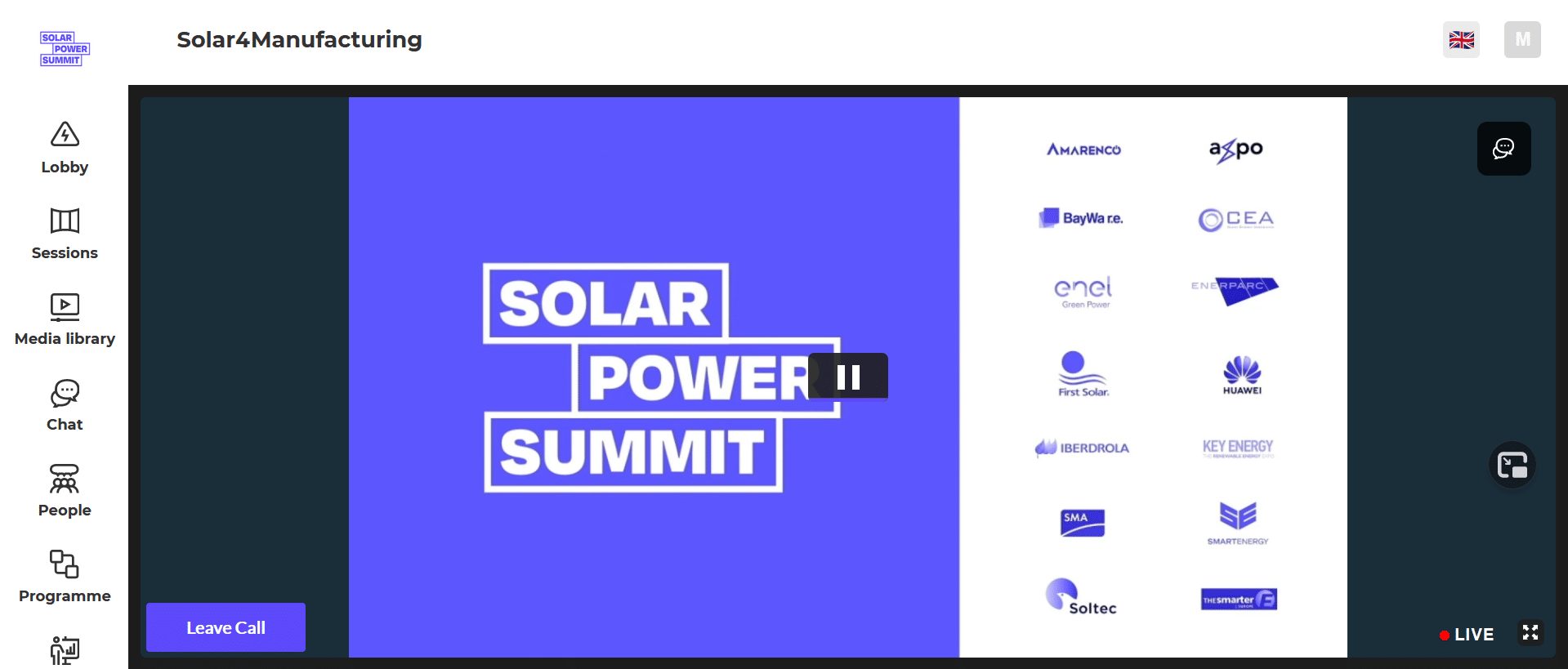
And we're back
Good Morning Folks,
We're back at the Solar Power Summit this morning, where the Solar4Manufacturing session is getting underway. Stay tuned for live coverage!
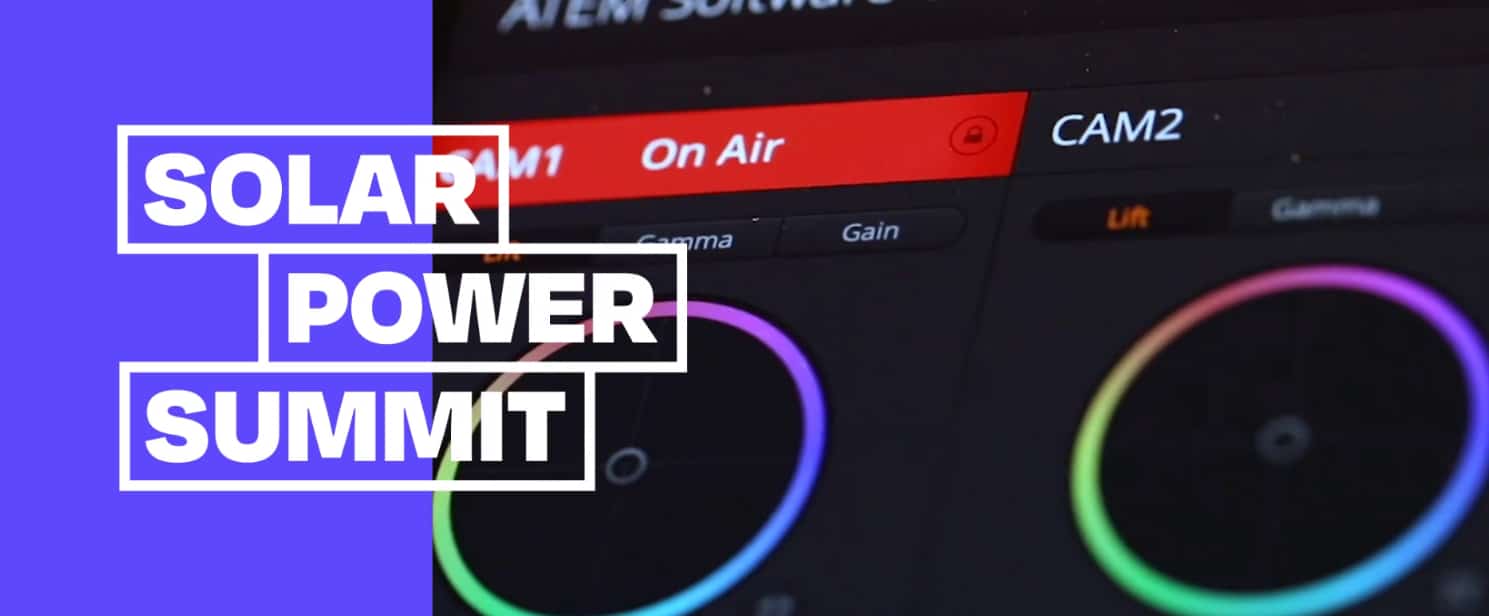
That's all folks
And that's where we're going to close our coverage of the SolarPower Summit for today, but we'll be back for more in the morning.
We are due to listen in on the contentious topic of European solar manufacturing from 9.30am (CET) tomorrow morning, so be sure to tune in and catch the latest updates.
Moraes beats the censor
Once again, at the close of the day's second panel session, youth leader Cassia Moraes' comments were infuriatingly interrupted constantly by a crashing broadcast platform, but we did manage to hear her float the interesting idea of linking re-skilling programs with ideas such as a universal basic income.
As the youth representative spelled out: “We should focus not only on creating jobs, but better jobs.”
Timmermans and Austrian cabinet member Gewessler both acknowledged the need to speed up permitting for clean energy projects, in answer to fresh calls made, not surprisingly, by panel members Salvatore Bernabei, of Enel Green Power, and Xabier Viteri, from the renewables arm of Spanish utility Iberdrola.
While the Austrian politician welcomed the idea of expanding the scope of the EU's designated Important Projects of Common European Interest in the energy sector, Timmermans held forth hope on the jobs front for Moraes and her peers. Discussing the problem of a feared “big shortage of labor in many sectors,” the commission VP said: “Given Europe's demographics, we should have full employment, if we're smart. We should give our young people the right training to equip them for a hydrogen economy.
“In batteries, I promise you, we will need 800,000 people to work in this sector. At some point, there will be big competition between the sectors to get people in, instead of the risk of wide unemployment.”
Bernabei, too, spoke of more immediate opportunities, with Enel's plans to establish a laboratory on Sicily where European start-ups will be able to experiment with electrolyzer technology linked to an existing renewable energy plant.
Host Hemetsberger gave the final word to Timmermans, who added: “We have no time to waste, we need to get going right now. It [the energy transition] will succeed if everybody does their part.”
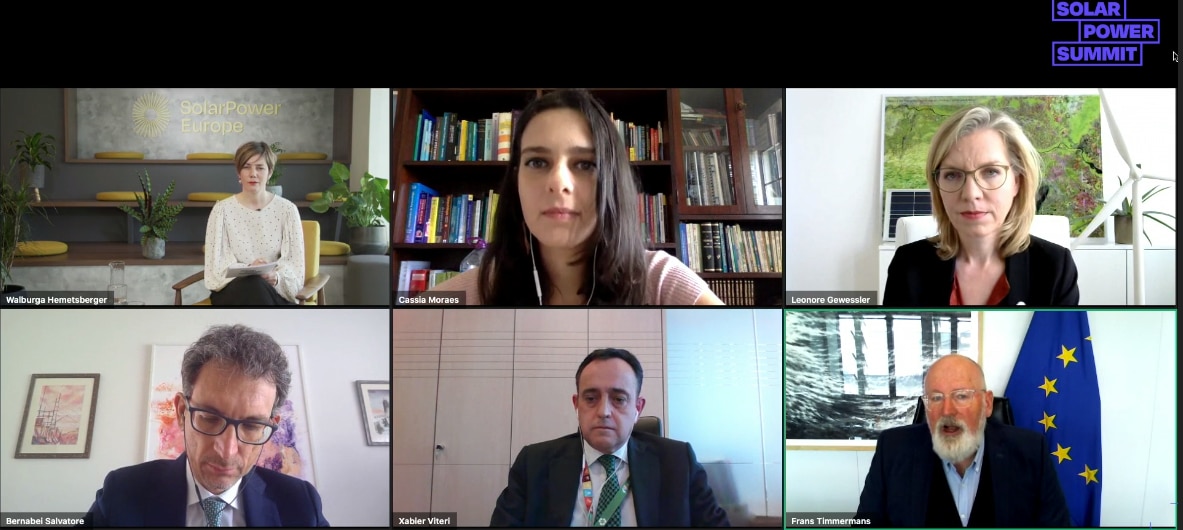
Here's the line-up
Austrian environment minister Leonore Gewessler is telling the panel what actions her government is making to ensure installing solar on rooftops is as easy as possible, and stressing the energy transition will involve a societal change, rather than just a technological one.
She is a busy person, judging by her full job title, by the way: federal minister for climate action, environment, energy, mobility, innovation and technology. Phew, it's amazing she's found time to talk today, just imagine how vast her business card must be.
European Commission VP Frans Timmermans is another familiar name on this panel and he made a valid point when he said Europe's leaders owe it to the younger generation to take heed of their environmental concerns after the youth of the continent agreed to surrender so many personal freedoms to safeguard the health of their elders over the past year or so. Got that right.
He was responding to apparently stirring comments from Cassia Moraes, founder and CEO of the Youth Climate Leaders body. Unfortunately, the ridiculous instability of the Tame Event platform broadcasting the event meant I spent all of her comments looking at a screen which told me the event had not started yet.
Cassia, tell us again please!
Back on the beat
Apparently there's been some sort of “stretching break” while I was feverishly typing my last update but there's no rest for your tireless pv mag correspondent, who is swiftly realizing the drawbacks of being able to cover such events from the sofa – there's none of the swanning round vast conference halls drifting suavely from lecture to lecture in this kind of set-up, I can tell you.
And so on we go with the next session: Solar4Ambitions. Man alive! For an ancient, grammar disciplinarian like myself, I'm not sure I can take a full three days of such outrages against the language.
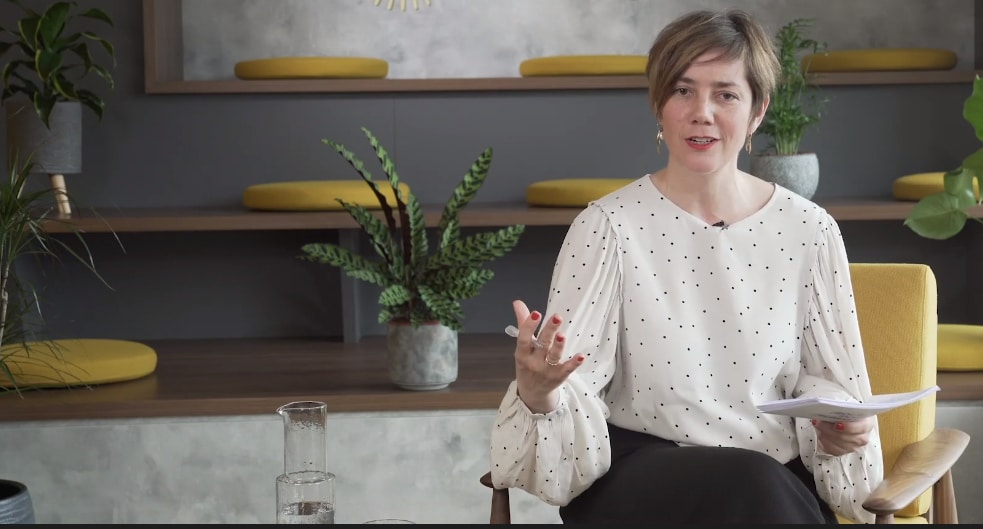
SOUND THE DIVISIVE TOPIC KLAXON!
Just when it all seemed like peace and light, solar cheerleader Hemetsberger only went and asked each of the panel members what one piece of legislation they would change in the year ahead (I know, as dinner party topics go it's a bit thin, but come on folks, we're all at work here.)
Anyhoo. Kristian Ruby, secretary general of European electric industry organization Eurelectric said the bloc's emissions trading scheme (ETS) needed beefing up so all power consumers pay the true cost of the electricity they produce. No more cheap fossil fuel power? That's pushing on an open door at this event, one might think.
However, the chemicals industry is a big electricity consumer so “none of the above,” replied Mensink when it was his turn in the chair, brilliantly alienating not just apparent clean power idealist Ruby but potentially everyone else on the panel too. “It's not making others expensive that makes yours cheaper,” said Mensink, “and we have to move beyond that.” He didn't have time to explain what was involved in making things cheaper, so instead pointed out perfidious EU governments would probably use their ETS income as an extra revenue stream rather than keeping the proceeds to drive the energy transition. To be fair, he's not wrong there, is he?
Elsewhere, there was a call from Arianna Vitali Roscini, sec-general for the Coalition for Energy Savings, and from Julie Baufils, her counterpart at EuropeOn (aaargh! Spaces, people!), for a tightening up of EU energy efficiency standards.
Chatzimarkakis said he wants EU state aid rules to be relaxed when it comes to hydrogen and renewables and wind industry rep Dickson said Article 19 of the bloc's Renewable Energy Directive must be reviewed to remove the ability of member states to conceal the origins of the clean power generated on their turf.
Lipid up
Chemicals rep Mensink is playing a prominent role in this panel and, in remarking on the need to widen supply chains – at the urging of SPE's “made-in-Europe” champion Walburga Hemetsberger – made an interesting contribution related to our ongoing Covid-19 misery.
The chemicals body director-general said it was only during the scramble to find a Covid-19 vaccine that the world realized it was dependent on one plastic bag producer in China for the lipids needed to roll out those oh-so-contentious injections.
Similarly, added Mensink, silicon solar panel manufacturing is entirely dependent on the supply of polysilicon, with Germany's Wacker the only notable producer in Europe.
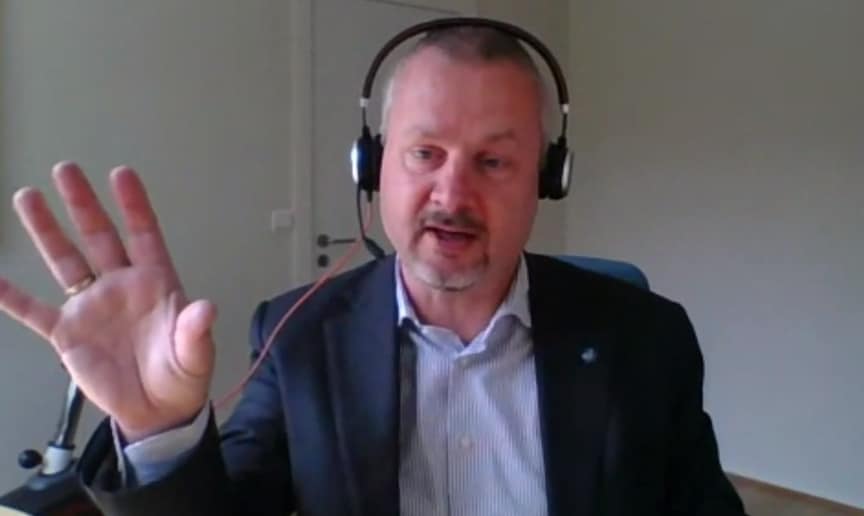
I want this bit, you can 'ave that...
Marco Mensink, of the European Chemical Industry Council, has expressed some exasperation at who will get all this renewable energy and green hydrogen we are planning for.
He said it's all very well discussing rapid electrification but he recently spoke to someone in the auto industry who said if that sector gets all the electric chargers it needs to make the energy transition, there will be no clean electricity left for industry. He called for a more structured debate about who needs what, and when.
For instance, said the chemicals chief, it's great to run buses on hydrogen but that might mean there's no clean hydrogen left for industry when the bus could have been electrified anyway.
He also had a swipe at the industry's oft-repeated talk about cost savings and cheap power and said the €0.05 clean power generated at solar and wind power sites can cost €0.15 by the time it reaches the chemicals industry, “more than we would pay in China.”
He endorsed the call for simpler regulation of the industry – you're likely to hear a lot of that over the next few days, and indeed at any industry conference, anywhere in the world, ever.
In terms of what constitutes “green hydrogen,” Jorgo Chatzimarkakis, secretary-general of Hydrogen Europe, said the need for a transparent system to identify the origins of hydrogen was paramount. That's a call which is unlikely to encounter any dissenters among this crowd and is a valid point, given the rainbow of colors of hydrogen apparently available already.
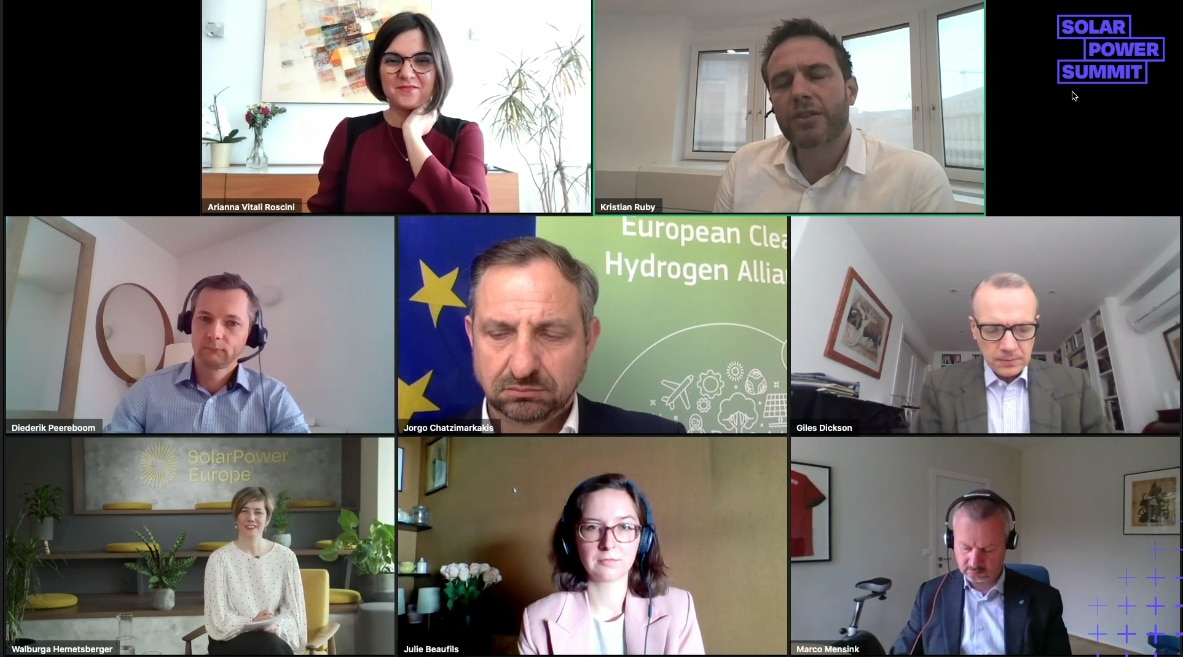
Can we Tame this broadcast?
Numerous people, myself included appear to be regularly losing the broadcast, somewhat giving the lie to the name of the technology platform we are tuning in to: Tame events.
In the meantime, as I furiously hit the refresh button, here's a picture of the panel which will allow us to compare their household interiors…
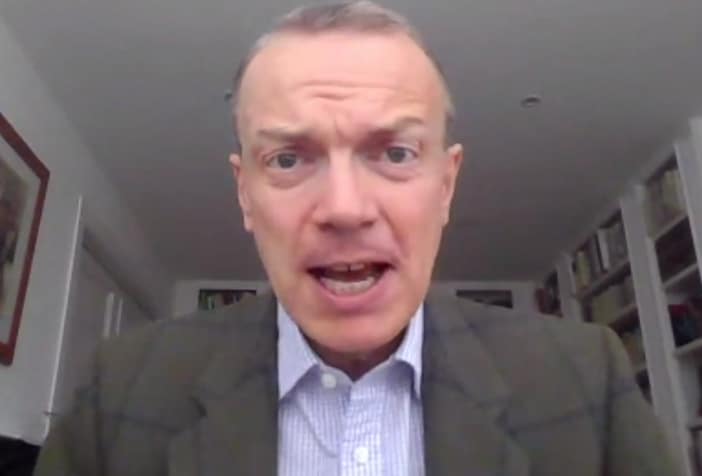
A solar panel
Now we're swiftly into a panel debate in which Giles Dickson, CEO of Wind Power Europe, is stating quite forcefully renewables “can be as cheap as you like,” and “you can install as much wind and solar project capacity as you like,” but that's no good at all under the current permitting regime.
He says securing permits is far too costly and time consuming across Europe and there is a shortage of staff to process applications.
His second gripe was about a lack of investment in energy infrastructure to get the electricity generated by solar and wind to users.
Aristotelian theory
Aristotelis Chantavas, president of both Enel Green Power and SPE, according to the list of event speakers, has kicked us off by trailing the publication of a sustainability best practice guide by the trade body on Wednesday, to mark the final day of the summit. It will be interesting to see what ramifications that document has for the world's biggest solar manufacturers, who are all, of course, based outside Europe.
Chantavas said the recent decision by the EU to shoot for a 55% reduction of carbon emissions, from a 1990 baseline, would require policy support.
By the way, on that sustainability issue, Chantavas also said SPE would unveil a ‘sustainability tracker,' although I'm not sure whether that will happen during this summit or by the end of the year.
Here we go!
Good afternoon folks, here is your pv magazine team broadcasting live from, well, that's not fooling anybody, is it? I'm coming to you from my lounge in northern Italy as it ‘appens, dashing between my desk and the coffee machine as required, to provide live coverage of this year's SolarPower Summit.
The annual event, which is being held virtually for the second time, will bring together the movers and shakers of European solar under the aegis of industry body SolarPower Europe, to look to what opportunities the future holds for the sector.
Who knows, if SPE – as I will refer to it from now on – manages to sell enough ads, maybe it'll even be able to purchase that elusive space character which will render it grammatically literate.
